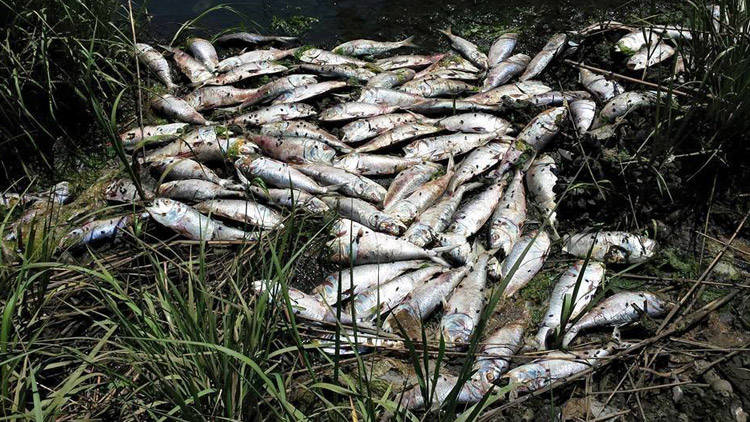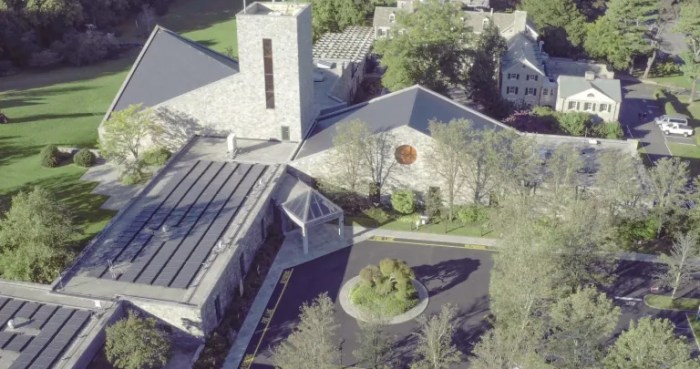By Kaitlin Gallagher
Thousands of dead bunker fish blanketed the shores of Flanders Bay last month, following the mass die-off of hundreds of diamondback turtles nearby. Tens of thousands more fish floated belly-up in Peconic River this week. Dark, cloudy waters muddied the Great South Bay and Moriches Bay along the South Shore recently, and toxic, blue-green algae coated Mattituck’s Lake Marratooka, prohibiting swimming.
The culprit, according to environmental experts: an overabundance of nitrogen in the water, which fuels harmful algae blooms called “brown” and “red” tides, and starves marine life of critical oxygen.
First appearing on Long Island in 1985, brown and red tide is infamous for destroying eelgrass beds, decimating local shellfish populations and wiping out the bay scallop fishery within the Peconic Estuary watershed between the North and South Forks. As the recent fish kills, terrapin die-offs and murky waters are evident, brown and red tide are back with a vengeance, prompting a coalition of environmental watchdog groups, health officials, scientists and Suffolk County legislators to converge last week at the legislature’s health committee meeting to hash out a strategy on how to best combat the blooms.
“The best thing that we can do is address the main source of the problem, which is our nitrogen,” said Dr. Alison Branco, director of the nonprofit Peconic Estuary Program, who was among those who spoke at the committee meeting.
Lawmakers in attendance included Legis. Robert Calarco (D-Patchogue), Legis. Monica Martinez (D-Brentwood), Legis. Robert Trotta (R-Fort Salonga), vice chair Kate Browning (WF-Shirley) and chair Dr. William Spencer (D-Centerport). Besides Branco, environmental experts in attendance inlcuded Walter Dawydiak, director of the Suffolk County Health Department Division of Environmental Quality; Dr. Christopher Gobler, a biologist at Stony Brook University; and Adrienne Esposito, executive director of nonprofit Citizens Campaign for the Environment.
Branco explained the extent of the current situation, attributing the dead bunker fish and diamondback turtles in Flanders Bay to unprecedented hypoxia—low dissolved oxygen levels. There has been such an issue every year, she said, but 2015 has been the first year hypoxia levels have remained at 0-percent oxygen for six to eight hours overnight. This, in addition to the large amounts of fish in one area, is a recipe for disaster, she told the panel.
Although brown tide is not harmful to humans, densities above 50,000 cells per milliliter can be harmful to marine life, explained a June 9 press release about the recent blooms issued by The Gobler Laboratory of Stony Brook University, which conducts extensive water monitoring. The “intense and damaging brown tide” appearing along the Great South Bay and Moriches Bay, though first discovered in May, it reads, has intensified to 250,000 cells per milliliter.
The panel agreed that septic tanks and failing cesspool systems are big contributors to the resurgence of brown and red tides in the Peconic Estuary and the toxic algae in Mattituck’s Lake Marratooka. Another factor is the public’s use of fertilizers, they explained. Decades of research at Stony Brook University has determined that high levels of organic nitrogen and poor flushing from wastewater treatment plants also contribute to these unsightly and sometimes lethal blooms.
“The picture’s clear, it’s septic waste seeping into embayments, causing low oxygen, causing harmful algal blooms, causing deterioration of our water bodies,” said Esposito, stressing that local lawmakers’ top priority should be revisiting Long Island’s comprehensive water quality report, also known as “The 208 Study,” which was last updated in 1978.
Marshall Brown from nonprofit Save the Great South Bay Campaign emphasized the importance of “develop[ing] new technologies for once the nitrogen is in the bay.” He also said that people have to remember that everything put on their lawn—chemicals, fertilizers, etc.—goes straight into our waterways and drinking waters.
The state has $8 million in “seed money” to help improve water quality, explained Esposito—funds that could be used to make much-needed first steps.
“It’s certainly not all we need, but it’s the beginning as we figure out the best way to transition from septics and cesspools to the newer wastewater technology,” she testified.
Dawydiak outlined several initiatives the county is already implementing to target the county’s nitrogen pollution crisis.
Suffolk County Executive Steve Bellone’s “Reclaim Our Waters Initiative,” launched in March 2014, is hoping to remove 10,000 South Shore residents off septic systems and transfer them to sewers, he said, describing it as a step in the right direction to help minimize brown tides. In Central and East Suffolk there is a septic demonstration program underway, he added, and 19 systems, which will remove nitrates from individual homes, are currently being installed.
Reducing the nitrogen is critical, agreed Dawydiak.
“If we reduce the nitrogen to the point where it needs to be reduced we will significantly improve the oxygen as well as help the wetlands,” he said.

























